Select units of measurement for the temperature and rainfall tables (metric or imperial).
Average weather, temperature, rainfall, sunshine
In Bosnia and Herzegovina we have the following climatic zones: the
Mediterranean climate, with mild winters and hot summers, in the small coastal stretch (see Neum), the transitional Mediterranean climate in the western plain (see Mostar), and the
continental climate, with cold winters and hot summers, in the hilly areas (see Sarajevo) and the northern plain (see Bihac, Tuzla). Then, we have the cold mountain climate of the Dinaric Alps.
Precipitation is abundant in the western part of Bosnia and Herzegovina, west of the mountains, where it amounts to 1,400 millimeters (55 inches) per year, and even more on the western mountain slopes, where it can exceed 2,000 mm (78 in). On the northern plain, on the other hand, it is moderate and gradually drops below 1,000 mm (40 in), until it reaches 750 mm (29.5 in) in the extreme north, on the border with Croatia.
In winter there can be
cold waves, typical of the Balkan Peninsula, which are felt in a large part of Bosnia with snowfalls and frosts, while they have less evident effects in the coastal area. In summer, on the other hand, there can be
very hot periods.
The climate in detail
The western plain
The country has a short
stretch of coast overlooking the Adriatic Sea, of about 7 kilometers (4 miles), for the rest, the border is just a few kilometers from the sea, while the coast belongs to Croatia.
The coastal area has a Mediterranean climate, with a mild, rainy winter and a hot, sunny summer.
Neum
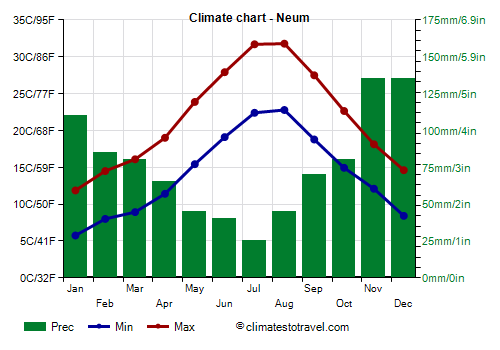
In
Neum, the average temperature ranges from around 9 °C (48 °F) in January to around 27 °C (80.5 °F) in July and August.
In winter, during cold spells, the temperature can drop to -5/-6 °C (21/23 °F), while in summer it can reach 38/39 °C (100/102 °F).
Precipitation amounts to about 1,000 millimeters (40 inches) per year.
Near Neum, the Adriatic
sea is warmest in July and August, when the water temperature is 24/25 °C (75/77 °F), while it's still acceptable in September, when the water temperature is 23 °C (73 °F), and a bit cool in June, when it's 22 °C (71.5 °F).
Mostar
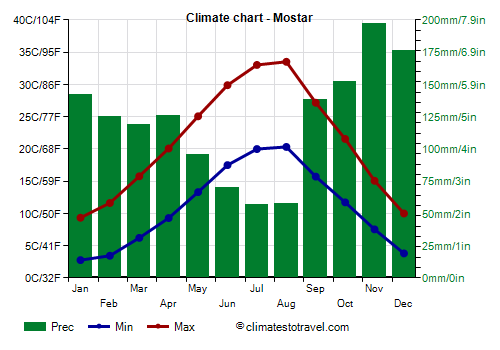
Behind the stretch of coastline, there is a plain, crossed by the Neretva River, where the city of Mostar is located (but also the pilgrimage site of Medjugorje), which has a transitional Mediterranean climate, with winters already a bit colder and
particularly hot summers. In summer, owing to the location a bit isolated from the sea, hot days are possible, with peaks above 40 °C (104 °F).
In
Mostar, the main center of Herzegovina, the coldest record is -11 °C (12 °F) and was set in January 1963. More recently, the temperature dropped to -9 °C (16 °F) in January 2017.
The highest record is 43 °C (109.4 °F) and was set in August 2007.
This is also a rainy area, since we are to the west of the mountains. The rainfall almost 1,500 millimeters (60 inches) per year, and the only relatively dry months are July and August, with around 50 mm (2 in) of rain.
In Mostar, the sun does not shine very often in winter, while it frequently shines in summer.
Hills and mountains
To the east of the small plain near the sea, we find the
Dinaric Alps, parallel to the coast. In this area, the climate becomes more continental at hill altitudes, while at higher altitudes we find an Alpine climate. Let's start with the cities located at an altitude of a few hundred meters.
In Livno, about 50 km (30 mi) away from the sea and 700 meters (2,300 feet) above sea level, the monthly average temperature ranges from in 1 °C (34 °F) in January and February to 20 °C (68 °F) in July.
Sarajevo
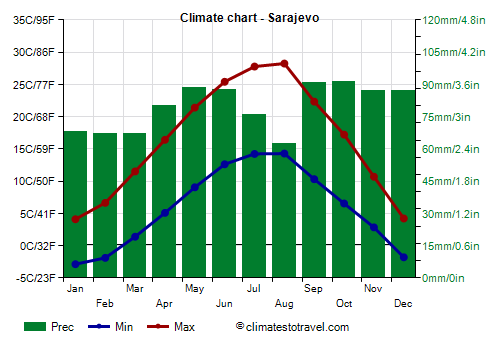
In
Sarajevo, the capital, 120 kilometers (75 miles) away from the sea and 500 meters (1,650 ft) above sea level, the average ranges from 0.6 °C (33 °F) in January to 21.3 °C (70.3 °F) in August.
In winter, during cold waves, the temperature can drop to -20 °C (-4 °F) and even below. The coldest record is -26.4 °C (-15.5 °F) and was set in January 1942. In recent years, the temperature dropped to -22 °C (-7.5 °F) in January 2017.
In summer, nights are usually quite cool, however, during the day it can sometimes get very hot, with peaks around 36/37 °C (97/99 °F) in July and August. The highest record is 40 °C (104 °F) and was set in August 1946.
Throughout this area of hills and low mountains, the
wind is quite frequent. In Sarajevo, the south-west wind, which blows more frequently in spring, is similar to the
Foehn, that is, a warm and dry wind descending from the mountains.
In Sarajevo,
precipitation is not as abundant as on the western side, because the mountains to the south partly protect it from the humid winds of the Adriatic. Precipitation amounts to about 950 mm (37.5 in) per year, but it's well distributed over the seasons. In fact, the rains brought by western frontal systems in the cold half of the year are replaced by afternoon thunderstorms in late spring and summer. In winter, there is a fair amount of snowy days.
The sun in Sarajevo is rarely seen in winter, while in summer, it shines quite often, though not as often as in Mostar and along the coast.
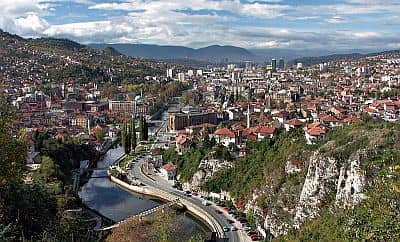
In the
high mountains, the climate gets naturally colder. The highest mountain is
Maglic, 2,386 meters (7,828 feet), on the border with Montenegro.
Bjelasnica
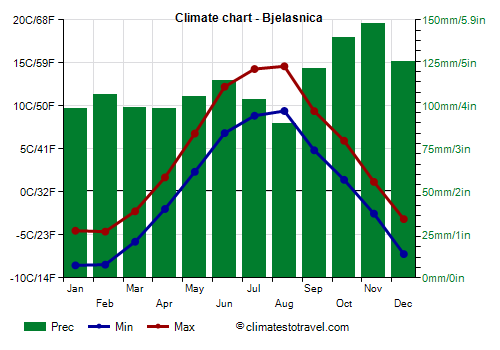
In Mount
Bjelašnica, south of Sarajevo, at an altitude of 2,000 metres (6,500 feet), the average temperature ranges from -6.5 °C (20.5 °F) in January to 12 °C (53.5 °F) in August. The coldest record is -29 °C (-20 °F), set in January 1963. The highest record is 24 °C (75 °F), set in August 2007.
Precipitation amounts to 1,300 mm (51 in) per year, and there is no dry season. In winter, heavy snowfalls occur.
The northern plain
On the northern side of the mountains we find low-lying valleys, while in northern Bosnia, near the border with Croatia, we find a flat area.
In this area, in cities such as Bihac, Tuzla, Banja Luka, the climate is of the
continental type, basically not very different from that of Sarajevo.
Banja Luka
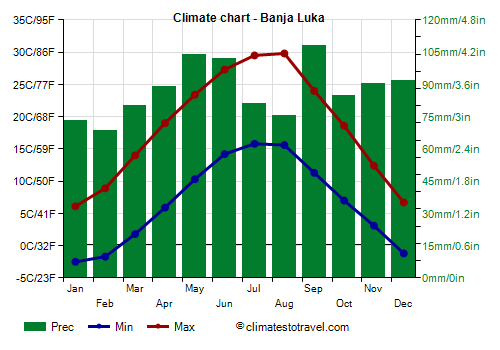
In
Banja Luka, the second largest city in Bosnia and Herzegovina, the average temperature ranges from 1°C (34 °F) in January to 22.5 °C (72.5 °F) in July. As far as extreme values are concerned, in the last thirty years the temperature has dropped to -23 °C (-9.5 °F) in February 2012, while it reached 40 °C (104 °F) in July 2007 and August 2012.
Here too, precipitation amounts to around 900/1,000 mm (35/40 in) per year, so it's still quite high, and also well distributed because of the frequent thunderstorms in summer.
In Banja Luka and in the northern plain, the sun shines 1,950 hours per year, more or less the same number of hours as in Sarajevo and in the hilly area.
When to go
The best time to visit most of Bosnia and Herzegovina, namely the hilly area (see Sarajevo) and the northern plain (see Bihac, Tuzla, Banja Luka), is from
June to September. However, given that some very hot days are possible in July and August, you may prefer June and September if you don't like the heat. The summer weather is often sunny, but thunderstorms can break out in the afternoon. Normally, nights are cool.
In the small western plain, in Mostar or Medjugorje, where in summer it is often very hot, you can choose
May, June, and September. In July and August, rainfall is rare, but it can sometimes be hot. From October to April, and therefore even in winter, the weather is usually mild, but sometimes it's windy, and in addition, the rains are abundant.
For a
beach holiday, the short coastal stretch, because of its Mediterranean climate, is good in summer (especially in July and August).
What to pack
In
winter: for Sarajevo and inland areas, bring warm clothes, such as a sweater, a down jacket, a hat, gloves, and a raincoat or umbrella. For the plain of Mostar and the coast: warm clothes, such as a sweater, a coat, and a raincoat or umbrella.
In
summer: bring light clothes, T-shirts, but also long pants, a light jacket and a sweatshirt for the evening and for cooler days, especially in inland areas; an umbrella.
Climate data - Bosnia Herzegovina
| Banja Luka |
|---|
|
| Jan | Feb | Mar | Apr | May | Jun | Jul | Aug | Sep | Oct | Nov | Dec |
|---|
| Min temp. | -2 | -2 | 2 | 6 | 10 | 14 | 16 | 16 | 11 | 7 | 3 | -1 |
|---|
| Max temp. | 6 | 9 | 14 | 19 | 23 | 27 | 30 | 30 | 24 | 19 | 12 | 7 |
|---|
| Precip. | 75 | 70 | 80 | 90 | 105 | 100 | 80 | 75 | 110 | 85 | 90 | 90 |
|---|
| Prec. days | 9 | 9 | 10 | 10 | 10 | 9 | 8 | 6 | 9 | 8 | 9 | 10 |
|---|
|
|
| Sun hours | 2 | 3 | 5 | 6 | 7 | 8 | 9 | 9 | 6 | 4 | 3 | 2 |
|---|
|
| Bihac |
|---|
|
| Jan | Feb | Mar | Apr | May | Jun | Jul | Aug | Sep | Oct | Nov | Dec |
|---|
| Min temp. | -2 | -1 | 2 | 6 | 10 | 14 | 15 | 15 | 11 | 8 | 4 | -1 |
|---|
| Max temp. | 6 | 8 | 13 | 18 | 22 | 27 | 29 | 29 | 23 | 18 | 12 | 7 |
|---|
| Precip. | 110 | 110 | 105 | 110 | 135 | 95 | 95 | 80 | 150 | 130 | 140 | 125 |
|---|
| Prec. days | 10 | 11 | 11 | 11 | 11 | 9 | 8 | 7 | 10 | 10 | 11 | 12 |
|---|
|
|
| Sun hours | 2 | 3 | 5 | 6 | 8 | 9 | 10 | 9 | 6 | 4 | 3 | 2 |
|---|
|
| Bijeljina |
|---|
|
| Jan | Feb | Mar | Apr | May | Jun | Jul | Aug | Sep | Oct | Nov | Dec |
|---|
| Min temp. | -2 | -1 | 2 | 6 | 11 | 15 | 16 | 16 | 12 | 7 | 3 | -1 |
|---|
| Max temp. | 5 | 8 | 14 | 19 | 24 | 28 | 30 | 30 | 24 | 19 | 12 | 6 |
|---|
| Precip. | 55 | 45 | 55 | 60 | 85 | 85 | 70 | 55 | 65 | 65 | 60 | 60 |
|---|
| Prec. days | 9 | 8 | 8 | 9 | 11 | 10 | 8 | 7 | 8 | 8 | 9 | 9 |
|---|
|
|
|
|
| Bileca (470 meters) |
|---|
|
| Jan | Feb | Mar | Apr | May | Jun | Jul | Aug | Sep | Oct | Nov | Dec |
|---|
| Min temp. | 0 | 0 | 3 | 5 | 10 | 13 | 15 | 15 | 12 | 8 | 4 | 0 |
|---|
| Max temp. | 9 | 10 | 14 | 17 | 21 | 27 | 28 | 31 | 26 | 18 | 14 | 9 |
|---|
| Precip. | 150 | 150 | 135 | 120 | 100 | 75 | 55 | 60 | 125 | 180 | 225 | 200 |
|---|
| Prec. days | 10 | 10 | 10 | 10 | 10 | 8 | 5 | 5 | 8 | 9 | 11 | 11 |
|---|
|
|
|
|
| Bjelasnica (2,000 meters) |
|---|
|
| Jan | Feb | Mar | Apr | May | Jun | Jul | Aug | Sep | Oct | Nov | Dec |
|---|
| Min temp. | -9 | -8 | -6 | -2 | 2 | 7 | 9 | 9 | 5 | 1 | -3 | -7 |
|---|
| Max temp. | -5 | -5 | -2 | 2 | 7 | 12 | 14 | 15 | 9 | 6 | 1 | -3 |
|---|
| Precip. | 100 | 105 | 100 | 100 | 105 | 115 | 105 | 90 | 120 | 140 | 150 | 125 |
|---|
| Prec. days | 13 | 14 | 12 | 12 | 13 | 11 | 10 | 9 | 10 | 11 | 13 | 14 |
|---|
|
|
| Sun hours | 3 | 3 | 4 | 5 | 5 | 7 | 8 | 8 | 6 | 5 | 3 | 3 |
|---|
|
| Cemerno (1,300 meters) |
|---|
|
| Jan | Feb | Mar | Apr | May | Jun | Jul | Aug | Sep | Oct | Nov | Dec |
|---|
| Min temp. | -5 | -5 | -2 | 2 | 6 | 10 | 12 | 12 | 8 | 4 | 0 | -4 |
|---|
| Max temp. | 2 | 2 | 6 | 10 | 15 | 19 | 22 | 22 | 17 | 13 | 7 | 2 |
|---|
| Precip. | 135 | 140 | 130 | 140 | 115 | 80 | 55 | 60 | 130 | 180 | 220 | 205 |
|---|
| Prec. days | 10 | 10 | 10 | 10 | 10 | 7 | 6 | 5 | 8 | 9 | 10 | 12 |
|---|
|
|
|
|
| Doboj |
|---|
|
| Jan | Feb | Mar | Apr | May | Jun | Jul | Aug | Sep | Oct | Nov | Dec |
|---|
| Min temp. | -3 | -2 | 2 | 6 | 10 | 14 | 16 | 16 | 12 | 7 | 3 | -1 |
|---|
| Max temp. | 5 | 8 | 14 | 19 | 23 | 27 | 29 | 29 | 24 | 19 | 12 | 6 |
|---|
| Precip. | 65 | 65 | 70 | 80 | 110 | 110 | 95 | 75 | 85 | 80 | 80 | 80 |
|---|
| Prec. days | 10 | 10 | 9 | 11 | 11 | 10 | 9 | 8 | 9 | 9 | 10 | 10 |
|---|
|
|
|
|
| Livno (725 meters) |
|---|
|
| Jan | Feb | Mar | Apr | May | Jun | Jul | Aug | Sep | Oct | Nov | Dec |
|---|
| Min temp. | -4 | -3 | 0 | 4 | 7 | 11 | 12 | 12 | 8 | 5 | 1 | -3 |
|---|
| Max temp. | 6 | 7 | 11 | 15 | 21 | 25 | 28 | 28 | 22 | 18 | 12 | 6 |
|---|
| Precip. | 100 | 90 | 90 | 95 | 90 | 70 | 55 | 55 | 110 | 110 | 170 | 130 |
|---|
| Prec. days | 9 | 9 | 9 | 10 | 9 | 8 | 6 | 6 | 8 | 9 | 11 | 10 |
|---|
|
|
| Sun hours | 4 | 4 | 5 | 6 | 7 | 8 | 10 | 9 | 7 | 6 | 4 | 3 |
|---|
|
| Mostar |
|---|
|
| Jan | Feb | Mar | Apr | May | Jun | Jul | Aug | Sep | Oct | Nov | Dec |
|---|
| Min temp. | 3 | 3 | 6 | 9 | 13 | 17 | 20 | 20 | 16 | 12 | 8 | 4 |
|---|
| Max temp. | 9 | 12 | 16 | 20 | 25 | 30 | 33 | 34 | 27 | 22 | 15 | 10 |
|---|
| Precip. | 140 | 125 | 120 | 125 | 95 | 70 | 55 | 55 | 140 | 150 | 195 | 175 |
|---|
| Prec. days | 10 | 9 | 9 | 10 | 9 | 7 | 5 | 5 | 7 | 8 | 11 | 11 |
|---|
|
|
| Sun hours | 4 | 4 | 6 | 6 | 8 | 10 | 11 | 10 | 8 | 6 | 4 | 4 |
|---|
|
| Neum |
|---|
|
| Jan | Feb | Mar | Apr | May | Jun | Jul | Aug | Sep | Oct | Nov | Dec |
|---|
| Min temp. | 6 | 8 | 9 | 11 | 15 | 19 | 22 | 23 | 19 | 15 | 12 | 8 |
|---|
| Max temp. | 12 | 14 | 16 | 19 | 24 | 28 | 32 | 32 | 27 | 23 | 18 | 15 |
|---|
| Precip. | 110 | 85 | 80 | 65 | 45 | 40 | 25 | 45 | 70 | 80 | 135 | 135 |
|---|
| Prec. days | 13 | 12 | 10 | 9 | 9 | 10 | 7 | 14 | 13 | 12 | 14 | 13 |
|---|
|
|
| Sun hours | 4 | 5 | 6 | 7 | 9 | 10 | 11 | 10 | 8 | 7 | 4 | 4 |
|---|
| Sea temp | 14 | 14 | 14 | 15 | 18 | 22 | 25 | 26 | 23 | 20 | 18 | 16 |
|---|
| Novi Grad |
|---|
|
| Jan | Feb | Mar | Apr | May | Jun | Jul | Aug | Sep | Oct | Nov | Dec |
|---|
| Min temp. | -2 | -2 | 1 | 6 | 10 | 14 | 16 | 15 | 11 | 7 | 3 | -1 |
|---|
| Max temp. | 5 | 8 | 13 | 18 | 22 | 26 | 28 | 28 | 22 | 17 | 11 | 5 |
|---|
| Precip. | 85 | 85 | 85 | 100 | 115 | 110 | 90 | 75 | 125 | 105 | 110 | 105 |
|---|
| Prec. days | 10 | 10 | 10 | 11 | 12 | 10 | 9 | 7 | 10 | 10 | 11 | 11 |
|---|
|
|
|
|
| Prijedor |
|---|
|
| Jan | Feb | Mar | Apr | May | Jun | Jul | Aug | Sep | Oct | Nov | Dec |
|---|
| Min temp. | -3 | -2 | 2 | 6 | 10 | 14 | 16 | 15 | 11 | 7 | 3 | -2 |
|---|
| Max temp. | 5 | 8 | 14 | 19 | 23 | 27 | 29 | 29 | 23 | 18 | 11 | 5 |
|---|
| Precip. | 65 | 60 | 65 | 80 | 90 | 90 | 75 | 70 | 115 | 90 | 85 | 80 |
|---|
| Prec. days | 8 | 8 | 8 | 10 | 10 | 9 | 7 | 6 | 9 | 9 | 9 | 10 |
|---|
|
|
|
|
| Sarajevo (500 meters) |
|---|
|
| Jan | Feb | Mar | Apr | May | Jun | Jul | Aug | Sep | Oct | Nov | Dec |
|---|
| Min temp. | -3 | -2 | 1 | 5 | 9 | 13 | 14 | 14 | 10 | 7 | 3 | -2 |
|---|
| Max temp. | 4 | 7 | 12 | 16 | 21 | 25 | 28 | 28 | 22 | 17 | 11 | 4 |
|---|
| Precip. | 70 | 65 | 65 | 80 | 90 | 90 | 75 | 65 | 90 | 90 | 85 | 85 |
|---|
| Prec. days | 10 | 10 | 9 | 11 | 11 | 10 | 9 | 7 | 9 | 9 | 9 | 10 |
|---|
|
|
| Sun hours | 3 | 4 | 5 | 5 | 6 | 8 | 8 | 8 | 6 | 5 | 3 | 2 |
|---|
|
| Srbac |
|---|
|
| Jan | Feb | Mar | Apr | May | Jun | Jul | Aug | Sep | Oct | Nov | Dec |
|---|
| Min temp. | -2 | -1 | 2 | 6 | 11 | 14 | 16 | 16 | 11 | 7 | 3 | -1 |
|---|
| Max temp. | 5 | 8 | 13 | 18 | 23 | 27 | 29 | 29 | 23 | 18 | 11 | 6 |
|---|
| Precip. | 45 | 40 | 50 | 60 | 75 | 85 | 60 | 65 | 80 | 75 | 70 | 60 |
|---|
| Prec. days | 9 | 9 | 9 | 11 | 12 | 10 | 9 | 8 | 10 | 10 | 10 | 10 |
|---|
|
|
|
|
| Trebinje (275 meters) |
|---|
|
| Jan | Feb | Mar | Apr | May | Jun | Jul | Aug | Sep | Oct | Nov | Dec |
|---|
| Min temp. | 2 | 3 | 6 | 9 | 13 | 17 | 20 | 20 | 15 | 11 | 8 | 4 |
|---|
| Max temp. | 10 | 12 | 15 | 18 | 24 | 28 | 32 | 32 | 26 | 21 | 16 | 12 |
|---|
| Precip. | 165 | 160 | 150 | 110 | 85 | 65 | 50 | 70 | 140 | 180 | 205 | 200 |
|---|
| Prec. days | 10 | 9 | 10 | 9 | 7 | 6 | 4 | 5 | 8 | 10 | 11 | 11 |
|---|
|
|
| Sun hours | 4 | 5 | 6 | 6 | 8 | 10 | 11 | 10 | 8 | 6 | 4 | 4 |
|---|
|
| Tuzla (245 meters) |
|---|
|
| Jan | Feb | Mar | Apr | May | Jun | Jul | Aug | Sep | Oct | Nov | Dec |
|---|
| Min temp. | -3 | -2 | 1 | 5 | 9 | 12 | 14 | 13 | 10 | 6 | 1 | -2 |
|---|
| Max temp. | 6 | 8 | 13 | 18 | 23 | 26 | 28 | 29 | 24 | 19 | 12 | 6 |
|---|
| Precip. | 60 | 55 | 60 | 70 | 105 | 115 | 95 | 70 | 75 | 75 | 70 | 70 |
|---|
| Prec. days | 9 | 10 | 9 | 10 | 11 | 11 | 9 | 7 | 8 | 8 | 8 | 10 |
|---|
|
|
| Sun hours | 2 | 3 | 5 | 6 | 7 | 8 | 8 | 8 | 6 | 5 | 3 | 2 |
|---|
|
| Zenica (345 meters) |
|---|
|
| Jan | Feb | Mar | Apr | May | Jun | Jul | Aug | Sep | Oct | Nov | Dec |
|---|
| Min temp. | -3 | -2 | 2 | 5 | 9 | 13 | 15 | 15 | 11 | 7 | 3 | -2 |
|---|
| Max temp. | 5 | 9 | 14 | 19 | 24 | 28 | 30 | 30 | 24 | 19 | 12 | 5 |
|---|
| Precip. | 55 | 55 | 55 | 70 | 80 | 85 | 85 | 60 | 80 | 70 | 75 | 70 |
|---|
| Prec. days | 9 | 8 | 9 | 10 | 10 | 10 | 9 | 6 | 8 | 8 | 8 | 9 |
|---|
|
|
|
|
See also the
temperatures month by month